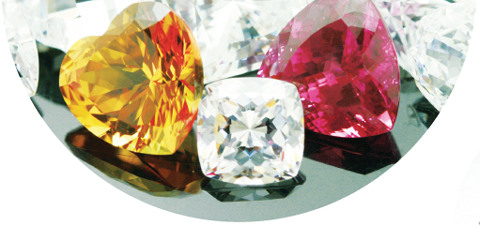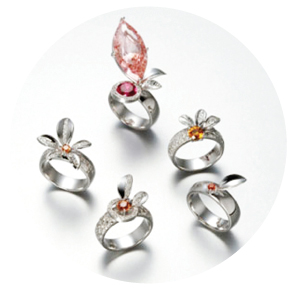
Q How did you start the jewelry studies?
These days, I research semiconductors. However, my bachelor’s degree was in Metal Engineering. In Metal Engineering, gold, silver and diamonds are typical materials that are used. Thanks to those experiences, I had advantages in the field of jewelry. Also, because I had developed specialized techniques in semiconductors, I was confident that it would be worthwhile to do a study about jewelry and alloys, using the same methods I use to research semiconductors.
Q What kinds of accomplishments have you achieved?
My first study was on technologies that are needed in the jewelry industry. In the jewelry market, diamonds are the most highly regarded gemstones, so I tried to study this elevated value of diamonds. As a result, our department’s studies were supported by UOS and eventually, we achieved a successful result, where, for the first time, we produced diamonds for jewelry at a domestic university. We now not only have the ability to improve the quality and color of natural gemstones, but we also have a lot of other patents in the field of jewelry research. As well, five years ago, along with the Graduate School of Design at UOS, we created jewelry, which was commissioned by and for the city of Seoul itself.
Q Are those accomplishments unparalleled?
To put it simply, the technology at UOS for synthetic gem-stones and precious metals is of the highest quality in Korea. In most of the other universities, jewelry research is done by focusing on metal craft by respective design departments. However, the differentiation factor of UOS is that the research here is done based on ‘engineering.’ Therefore, we can have advantages such as developing patents or know-hows and transferring patented technology to related businesses for jewelry or diamonds. Initially, people were not really interested in these aspects. Regardless of it, this time, I transferred three patents for diamonds, so I thought it was worth doing it. I hope someday the fact that UOS is contributing substantially to the jewelry industry will become widely known.

It is because students in our major generally prefer lectures about semiconductors and high-tech fields. Frankly, students, as well as most faculty at UOS are conservative. So, a few years ago, when I said “I research diamonds,” I was wrongly perceived as having an affair with jewelry. The word ‘fusion’ has become a rising keyword these days, however, back then, I felt a little sorrow.
Q Then, how can UOS students take classes about jewelry?
Even though there are no jewelry-related majors in the Dept. of Materials Science and Engineering, the class ‘Appreciation of Jewelry and Design’ began to be offered for general students three years ago. Female students, in particular, are interested in this class. It is operated to teach students about which jewelry suits them best, how to wisely measure the value of materials and marketing strategies about luxurious jewelry. Those three points are fused together in class.
As a more advanced course, the Graduate School of Science and Technology was established in 2006. Since then, research on how to develop technology, where jewelry is further spotlighted for consumers, is constantly being done. Alumni are mostly engaging in the jewelry industry in the Cheongdam-dong and Jongno areas that are famous for jewelry industry. We have already produced around 50 students, and we have even recently created an alumni association for them.
Q The word ‘fusion’ has come up a lot in your words. What does the word ‘fusion’ mean to you?
I think ‘fusion’ will become more important in modern society. Therefore, I am trying to lead my research and education toward the fusion of technology with humanities or design, but it is harder than I thought. I used to mention bibimbap as a metaphor of ‘fusion.’ Before mixing, bibimbap looks delicious and beautiful. However, when it is thoroughly mixed, it is hard to distinguish bibimbap from dog food. Likewise, research and education also should be mixed little by little, not all at once. So far, if I were figuratively speaking, I have passed the early stages and have now located the next step to make more delicious and visually good bibimbap through mixing red pepper paste and eggs. I am doing my best to improve fusion education like bibimbap.
Q Your stage name is unique. Is it also implicit in ‘fusion’?
Yes. My stage name is ‘Art-te Song.’ I think if technology is combined with art, its value can increase among the public and consumers. For me, ‘Art Song’ alone seemed countrified. ‘Art’ in Italian is ‘Arte.’ Because I wanted to join ‘Art’ to the ‘Technology’ field, Art-te Song (‘ARTe’+‘Technology’=Art-te) seemed better. When I go abroad or participate in jewelry fairs, I leave business cards with ‘Art-te Song’ on them. People then consider me a unique person or mistake me from someone who has studied jewelry in Italy.
Q What can UOS students look forward to regarding Art-te Song’s future activities?
Until I retire from teaching, I will strive to focus on research and education, with the hope that my students will contribute to the Korean jewelry industry and become valuable like ‘jewelry.’ After retiring, I will put a lot of effort to become a master craftsman in the field of jewelry production and design. An interesting fact is that the trends of high-tech fields like Materials Science and Engineering change too quickly to keep up with the latest information. However, in the field of jewelry, people are recognized as masters over long periods of time. Therefore, I hope I keep my composure, while developing jewelry design during the second half of my life, and eventually I would like to be recognized as one of the masters.

After the interview, Prof. Song gave me a silver ring that he had created as a gift for coming to interview him. While smiling, he said the real charm of jewelry might be the ‘happy communion’ between people who give and take the jewelry. Prof. Song’s upcoming studies, especially the ones focused on ‘fusion’ technology with sensitivity, are definitely something to look forward to.
All these jewelry are created by Prof.Song
All photos credited by Song Oh-sung
Yoon Hye-lin Vice Editor-in-Chief
dnr425@uos.ac.kr

